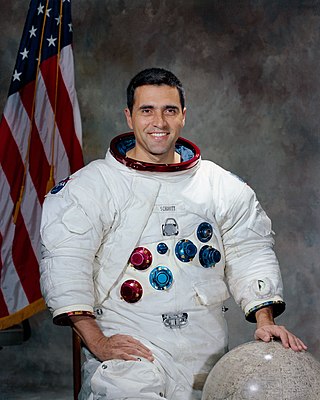
Harrison Hagan Schmitt is an American geologist, retired NASA astronaut, university professor, former U.S. senator from New Mexico, and the most recent living person—and only person without a background in military aviation—to have walked on the Moon.

Alan LaVern Bean was an American naval officer and aviator, aeronautical engineer, test pilot, NASA astronaut and painter. He was selected to become an astronaut by NASA in 1963 as part of Astronaut Group 3, and was the fourth person to walk on the Moon.

The flag of Scotland is the national flag of Scotland, which consists of a white saltire defacing a blue field. The Saltire, rather than the Royal Standard of Scotland, is the correct flag for all private individuals and corporate bodies to fly. It is also, where possible, flown from Scottish Government buildings every day from 8:00 am until sunset, with certain exceptions.

Andrew "Andy" Sydney Withiel Thomas, AO is an Australian and American aerospace engineer and a former NASA astronaut. He has dual nationality; he became a U.S. citizen in December 1986, hoping to gain entry to NASA's astronaut program. He is married to fellow NASA astronaut Shannon Walker.

STS-41-G was the 13th flight of NASA's Space Shuttle program and the sixth flight of Space Shuttle Challenger. Challenger launched on October 5, 1984, and conducted the second shuttle landing at Kennedy Space Center on October 13, 1984. It was the first shuttle mission to carry a crew of seven, including the first crew with two women, the first American Extravehicular activity (EVA) involving a woman (Sullivan), the first Australian-born person to journey into space as well as the first astronaut with a beard and the first Canadian astronaut.
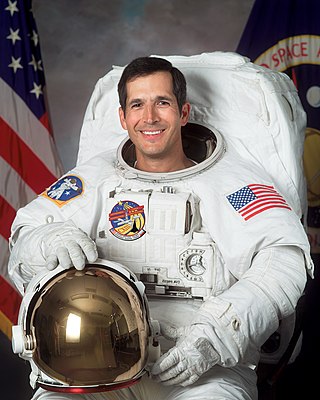
John Bennett Herrington is a retired United States Naval Aviator, engineer and former NASA astronaut. In 2002, Herrington became the first enrolled member of a Native American tribe to fly in space.

Piers John Sellers was a British-American meteorologist, NASA astronaut and Director of the Earth Science Division at NASA/GSFC. He was a veteran of three Space Shuttle missions. Sellers attended Cranbrook School, Cranbrook, Kent, United Kingdom, until 1973, and achieved a bachelor's degree in ecological science from the University of Edinburgh in 1976. In 1981 he gained a doctorate in biometeorology from the University of Leeds. In 2011, Sellers retired from the NASA Astronaut Corps.
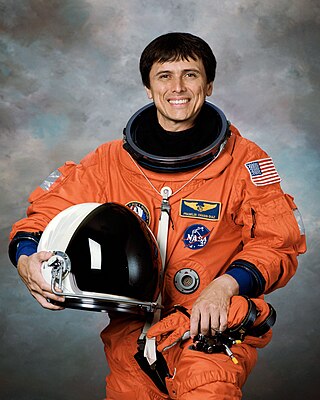
Franklin Ramón Chang-Díaz is an American mechanical engineer, physicist and former NASA astronaut. He is the sole founder and CEO of Ad Astra Rocket Company as well as a member of Cummins' board of directors. He became an American citizen in 1977.
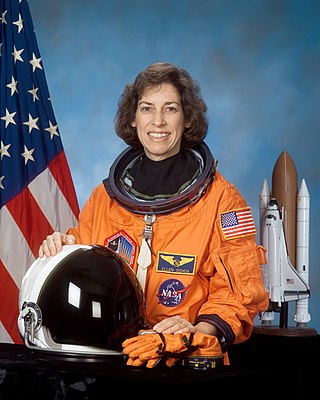
Ellen Ochoa is an American engineer, former astronaut and former director of the Johnson Space Center. In 1993, Ochoa became the first Hispanic woman to go to space when she served on a nine-day mission aboard the Space Shuttle Discovery. Ochoa became director of the center upon the retirement of the previous director, Michael Coats, on December 31, 2012. She was the first Hispanic director and the second female director of Johnson Space Center.
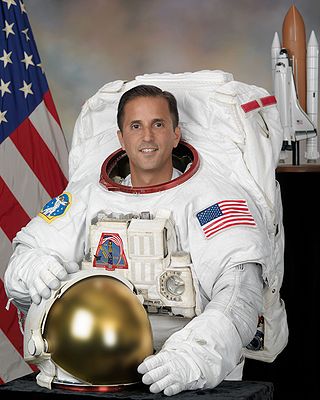
Joseph Michael Acabá is an American educator, hydrogeologist, and NASA astronaut. In May 2004 he became the first person of Puerto Rican heritage to be named as a NASA astronaut candidate, when he was selected as a member of NASA Astronaut Training Group 19. He completed his training on February 10, 2006, and was assigned to STS-119, which flew from March 15 to 28, 2009, to deliver the final set of solar arrays to the International Space Station.

The British Interplanetary Society (BIS), founded in Liverpool in 1933 by Philip E. Cleator, is the oldest existing space advocacy organisation in the world. Its aim is exclusively to support and promote astronautics and space exploration.
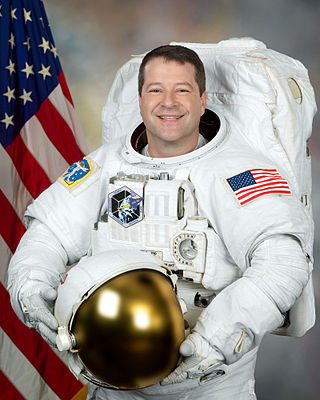
Nicholas James MacDonald Patrick, is a British-American engineer and a former NASA astronaut. His flight on the 2006 Discovery STS-116 mission made him the fourth person born in the United Kingdom to go into space.

Catherine Lucy Hawking is an English journalist, novelist, educator, and philanthropist. She is the daughter of the theoretical physicist Stephen Hawking and writer Jane Wilde Hawking. She lives in London, and is a children's novelist and science educator.
The Sir Arthur Clarke Award is a British award given annually since 2005 in recognition of notable contributions to space exploration, particularly British achievements. Nominations for the awards are made by members of the public, with shortlists drawn up by a panel of judges, who also choose the winner. Sir Arthur C. Clarke chose a special award independently of the public nominations.

Katherine Megan McArthur is an American oceanographer, engineer, and NASA astronaut. She has served as a Capsule Communicator (CAPCOM) for both the Space Shuttle and International Space Station (ISS). Megan McArthur has flown one Space Shuttle mission, STS-125 and one SpaceX mission, SpaceX Crew-2 on Crew Dragon Endeavour. She is known as the last person to be hands on with the Hubble Space Telescope via the Canadarm. McArthur has served in a number of positions including working in the Shuttle Avionics Laboratory (SAIL). She is married to fellow astronaut Robert L. Behnken.
The British space programme is the British government's work to develop British space capabilities. The objectives of the current civil programme are to "win sustainable economic growth, secure new scientific knowledge and provide benefits to all citizens."
Christopher Riley is a British writer, broadcaster and film maker specialising in the history of science. He has a PhD from Imperial College, University of London where he pioneered the use of digital elevation models in the study of mountain range geomorphology and evolution. He makes frequent appearances on British television and radio, broadcasting mainly on space flight, astronomy and planetary science and was Visiting Professor of science and media at the University of Lincoln between 2011 and 2021.
Robert Godwin is a British author who has written about rock music and spaceflight. Early in his career he was a rock music impresario who managed a venue in Burlington, Ontario, and founded Griffin Music.
Elizabeth "Libby" Anne Jackson is a British space exploration expert who works for the UK Space Agency.














